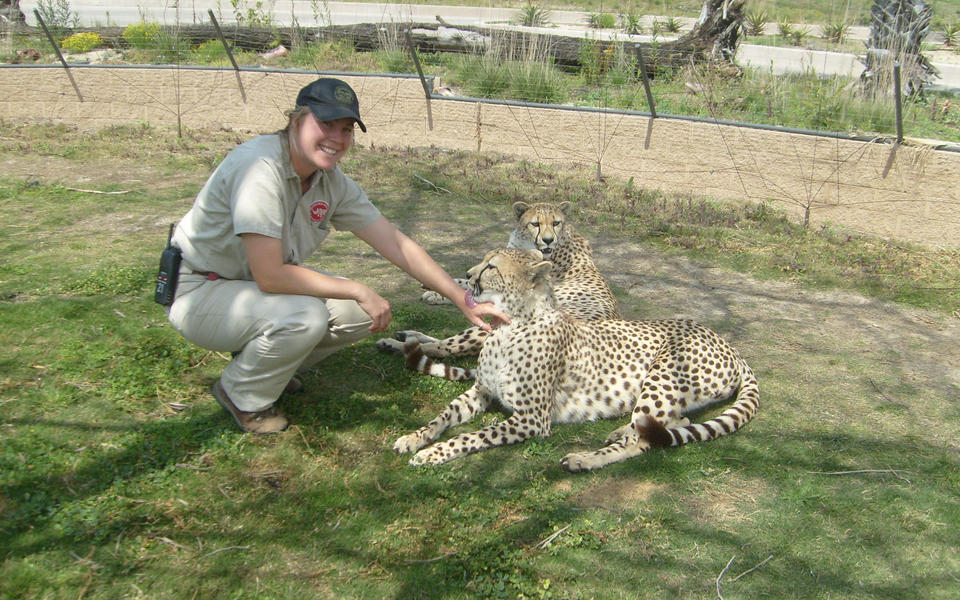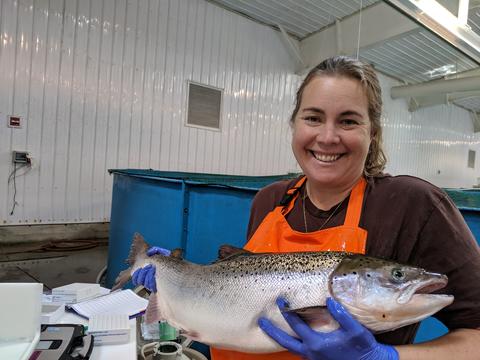Taking Measure
Just a Standard Blog

Me at the San Diego Zoo Safari Park in 2007 or so.
Every vertebrate on the planet has evolved a complex system that uses small molecules called hormones to communicate directives to isolated tissues that impact everything in the body from eating to producing babies. This hormonal communication between tissues is critical during reproductive processes. From the production of eggs and sperm, to placenta development, to birth, tissues are in constant hormonal communication.
At the National Institute of Standards and Technology (NIST) in the Hollings Marine Laboratory in Charleston, South Carolina, I measure hormones in the hopes of deciphering the communications between these tissues. Basically, I’m a biological eavesdropper, and like any good eavesdropper, I must know all the details to truly understand a story. However, for years, people who study hormones, known as endocrinologists, have been measuring single hormones at a time, and these individual measurements only told a small part of the biological story.
Single hormones found in blood don’t tell the eavesdropper where they came from and where they went. You see, these single hormones studied are almost always modified into hormone metabolites by different tissues. A combination of these metabolites is a hormone profile or unique hormonal “dialect” that tissues use to communicate specific directives. Measuring these metabolites will allow endocrinologists to listen to the body’s hormonal story for further understanding of biological systems.
Within biological systems, my main interest is the story of reproduction. I use a technique known as liquid chromatography mass spectrometry (LC-MS) to measure hormones and their metabolites. This technology allows me to accurately measure at least 20 different hormones at one time, providing a hormone profile for each tissue so I can better understand the full reproductive conversation. For example, measuring the hormone progesterone can tell you a horse is pregnant, but measuring progesterone plus six other hormones and hormone metabolites can tell you exactly how far along the pregnancy is down to a few weeks. We can apply this concept to animal agriculture production, wildlife conservation and even human fetal and maternal health during pregnancy.
As a National Research Council (NRC) postdoctoral fellow here at NIST, I am working on a project to help solve the mystery of why the fertility rate of Atlantic salmon has dropped 30% in the past 20 years. To understand what’s going on reproductively in these economically important fish, we measure hormones in Atlantic salmon mucus.
But wait, you might say, aren’t hormones in blood? Yes, yes, they are! Well, then, why muck around with mucus?
There are many ways to measure hormones that don’t require a needle. Besides fish mucus, hormones can be found in feces, saliva, hair, milk, feathers and even baleen, providing many alternative methods to study hormones in animals. It’s markedly easier to collect mucus from a fish or urine from a cheetah than blood. These alternative sample collection methods are important for measuring hormones not only in wild animals but humans as well. What pregnant woman would choose to be poked 500 times with a needle rather than pee in a cup?

In conjunction with the USDA’s National Cold Water Marine Aquaculture Center, I collected mucus samples from reproductively active fish with the hope of decoding the hormonal conversation of highly fertile fish. If we can identify this “highly fertile” hormone profile, then producers will be able to select those fish for breeding, thereby improving the Atlantic salmon fertility rate.
My investigation into noninvasive measures of hormones using fish mucus reminded me of the days I spent collecting fecal samples as a zookeeper at the San Diego Zoo Safari Park and analyzing them at the San Diego Zoo Wildlife Alliance. It was there that I was first introduced to the idea of noninvasively monitoring wildlife reproduction through hormones in feces. Although, let me tell you, getting hormones out of feces is about as stinky as it gets! Stinky or not, I loved the work and thought, “Hey, maybe other institutions would be just as interested in noninvasive hormone measurements as I am!”
It turns out there were two organizations that jumped at the chance: the National Institute of Environmental Health Sciences (NIEHS), which is part of the National Institutes of Health, and the Smithsonian Conservation Biology Institute (SCBI). Both institutions were interested in NIST’s unique ability to measure steroid hormones with liquid chromatography high resolution mass spectrometry (LC-HRMS) and tandem mass spectrometry (LC-MS/MS) to enhance their respective reproductive programs. These technologies will be used to first identify (LC-HRMS) and then measure (LC-MS/MS) hormone metabolites in the urine of pregnant animals: humans and cheetahs, respectively.
Endocrinologists love to say “Hormones didn’t evolve to fit the animal. Animals evolved to fit the hormone.” Or, simply put, the progesterone from the Atlantic salmon looks exactly the same as human or cheetah progesterone. However, each of these animals use and metabolize progesterone differently during different reproductive events, resulting in two institutions asking very different questions (on different species) that we can answer with one measurement method.
The question from NIEHS concentrates on early pregnancy health in women and started way back in the 1980s. Between 1982-1986, women collected urine daily from the first day of their last period before they got pregnant until they were eight weeks pregnant. We’re talking over 10,000 urine samples! This remarkable data set was collected by a group led by Donna Baird who wanted to study early pregnancy. When I reached out, both Donna and her colleague Anne Marie Jukic immediately thought of this sample set, and together, we are working to identify the hormone metabolites that can detect both the timing and health of pregnancy.
To do this, there are two pregnancy outcomes in this study: One group had pregnancies that went to full term, and the other group miscarried after eight weeks. Within these two groups there were three distinct time points that center around placental development. In measuring urinary hormone metabolites at the early stages of placental development, we hope to identify a hormone profile that indicates the health of the placenta and potentially fetal health. This information can help doctors better care for their patients and prevent pregnancy loss.
SCBI was also interested in this project to improve the care of its patients! Animals don’t speak “human,” so our only way of communicating with them is with physiological biomarkers. If SCBI could measure hormone metabolites in the urine of endangered animals, we might be able to describe their reproductive processes in more detail and determine reasons for infertility and pregnancy loss. Understanding these issues is also key if we’re going to help save animals from extinction.
SCBI had an impressive urine bank from pregnant cheetahs and was excited to use these samples to study cheetah reproduction. You see, cheetahs are tricky. They breed really well in the wild but poorly in captivity. Unfortunately, in the wild they’re being hunted and losing habitat to the point that cheetah numbers are extremely low. Adrienne Crosier at SCBI focuses on understanding fundamental carnivore biology to improve reproduction, and she is specifically interested in understanding causes of infertility in big cats, primarily cheetahs. Adrienne, along with Janine Brown and Budhan Pukazhenthi, expressed interest in using LC-MS technologies to identify the hormone metabolites that differ between pregnant and nonpregnant cheetahs.
Just as cheetahs use spots for camouflage, their bodies use progesterone to camouflage pregnancy. Once a cheetah breeds, she releases the same amount of progesterone no matter if she’s pregnant or not pregnant. This phenomenon is called pseudopregnancy and occurs in many carnivores. A single hormone can’t help us detect a pregnant cheetah, but a hormone profile will hopefully define placental metabolism of hormones in cheetahs and give researchers a reliable detection method to improve the management of these charismatic cats. On a personal note, I was extremely excited to work with wildlife again. It felt like my original training in wildlife endocrinology had come full circle.
Whether I’m measuring hormones in fish mucus to study ovulation or urinary hormone metabolites to measure healthy pregnancies, I am always grateful that I get to work on what I love! I get to be a biological eavesdropper on the reproduction of animals. And I do have to say … that’s pretty amazing!






Fascinating....I now know that different tissues metabolize a Suite of hormones differently.